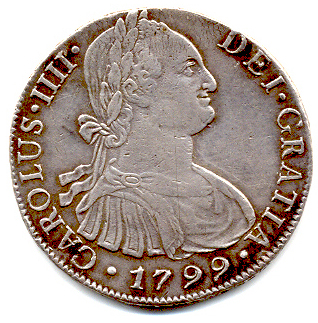Pieces of Eight and Two Bits
 There was a time in America when rather than U.S. dollars or British pounds, most people bought and sold with Spanish coins.
There was a time in America when rather than U.S. dollars or British pounds, most people bought and sold with Spanish coins.
During the 18th century, gold and silver were precious commodities. No active mines were operating in British North America, and Britain was keeping a tight hold on its own precious metals, leaving little for the colonists. However, America’s neighbors to the South were swimming in the stuff, and even though Mexico was printing its own coins, the dominant form of currency in the original 13 was that of Spain, with its dollar or peso (equal to 8 reales, thus it was known as “pieces of eight”), and smaller denominations the medio peso (equal to 4 reales) and peseta (equal to 2 reales).
This method of dividing the dollar into eight pieces had a lasting impact on American currency, since, like the medio peso, the United States has a half-dollar, and like the peseta, there is that favorite of parking meters and laundry mats, the quarter-dollar.
As part of the transition, the unit of account, at least colloquially, changed from real to “bit” in the U.S., and, thus, the quarter dollar, or quarter as we call it today, which was equal to two reales, came to be known as “two bits.”
Back in the day, two bits was not chump change. Even in the early 20th century, for instance, at Fraunces’ Tavern in New York City, you could get a dozen oysters or little neck claims, a plate of anchovies or a cup of chicken soup for $0.25 (two bits; today about $6.15). A cold roast beef sandwich cost $0.50 ($12.31 today), and a piece of apple pie could be purchased for $0.15 ($3.69 today).
Compare that with today’s prices at New York’s Carnegie Deli, and you begin to understand how two bits lost our respect. Today at the famous delicatessen, a plate of pickled herring costs $7.99 (about 32 bits), a bowl of chicken noodle will set you back $8.99 (about 36 bits), a roast beef sandwich (although I’m told the pastrami is the specialty) is $17.99 (a whopping 72 bits), and a piece of apple pie, albeit deep dish, costs $9.49 (about 38 bits).
So early on “two bit” wasn’t a pejorative, but somewhere along the way, presumably as prices increased via inflation while the value of a bit did not, the negative connotation came.
In any event, by the 1930s, the negative meaning had started to take hold. One early example can be seen in a rather crude line from Caldwell’s 1932 Tobacco Road: “She used to be a two-bit slut.”
If you liked this article, you might also enjoy our new popular podcast, The BrainFood Show (iTunes, Spotify, Google Play Music, Feed), as well as:
- Why a Dollar is Called a “Buck”
- Where the Dollar Sign Comes From
- What E Pluribus Unum Means
- The Speech That Cost Nearly a Billion Dollars
- Why Some Coins in the United States Have Ridges
Bonus Facts:
- In S.E. Hinton’s The Outsiders, Two-Bit Matthews earned his nickname honestly, as Ponyboy says, “You couldn’t shut up that guy; he always had to get his two bits worth in. Hence his name. Even his teachers forgot his real name was Keith.”
- The tune for “Shave and a Haircut . . . two bits” was widely used around the globe, although “two bits” was sung only in the United States. In England, the song had the same beginning but ended with “five bob.” The Mexican version was essentially an insult: “chinga tu madre . . . cabrón!” An in Italy, one version would have you “kill the old lady . . . with Flit,” a type of DDT. Regardless, men’s haircuts (without a shave) haven’t cost $0.25 since the financial panic of 1873 sent the cost for one crashing from $0.35 to $0.25. Even during the Great Depression, when prices again were lowered, a haircut cost $0.50. During World War II, haircut prices had risen to $0.85 or $1.00 on the weekends. By this time, weekday shaves cost $0.50, and more on the weekend. Today, the average cost for a men’s cut is $28, while for women, it is $44. That’s a lot of bits.
- Pieces of eight were legal tender in the USA until 1857.
- Apparently minted from silver, a piece of eight in 1600 was worth the equivalent of £50 in 2010 (about $75). Its metal alone on today’s market would be worth about $16. The silver, which was also responsible for financing its military, came from Bolivia’s “silver mountain,” a difficult place that over the ages has seen an estimated 33 million people pressed into forced labor. Today, the silver mountain has voluntary labor, but it has been so heavily mined (it has 600 mines and 100 km of passageways), that its internal structure is seriously weakened. As such, in July 2014, officials announced plans to close down operations above 14,435 feet.
| Share the Knowledge! |
|




